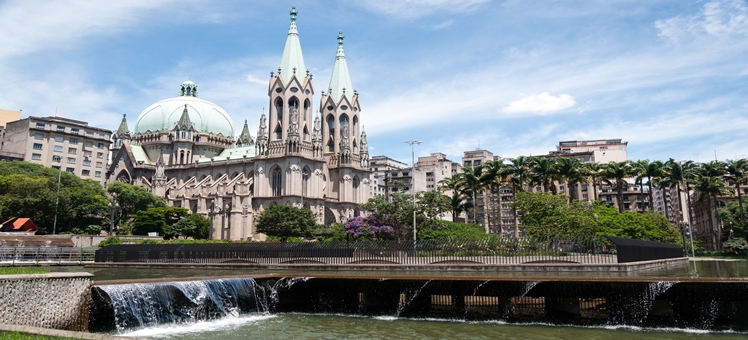
Sao Paulo is the largest city in Brazil and is the capital of the state of the same name, established in honor of Saint Paul of Tarsus. With a significant population of over 11 million Paulistanos (local inhabitants), the city is a teeming metropolis with regional influences of arts and entertainment. Its culture reaches far beyond history and stretches into the modern day with worldwide acclaimed events such as the Brazilian Grand Prix and the world’s largest Gay Pride Parade.
DowntownDowntown is the smallest area in the city, located right in the heart. This is where most of the historical sites and cultural centers are situated, and where a huge amount of diverse people live and work. Otherwise known as Centro, the area dates back to 1554. The historical architecture here ranges from the artistic baroque style to neoclassical buildings, some of which resembles architecture found in Vienna and Paris. Visit Praca da Se, the central square full of palm trees, a huge water fountain and the prettiest cathedral in town.
Southwest
This is one of the most vibrant parts of the city, which is home to plenty of culture and on the other end of the scale a great nightlife scene. This area represents the modern Sao Paulo with excellent restaurants, masses of culture and business, making it perfect for business and leisure travelers. Here you will also find the gap between rich and poor most prominent, where mansions and slums sit within close proximity of one another, making it the most diverse, but insightful area of Sao Paulo.
West
Another very vibrant part of the city, full of restaurants, bars, galleries and culture in general. Visit Vila Madalena for a more bohemian vibe full of brightly colored street art. The west is home to high rise buildings brightly lit up at night time and a huge range of choice in all departments. Here’s where you’ll find the biggest nightlife neighborhood, Vila Madalena that becomes a cultural and gastronomic point during the day. Some of the nicest and most expensive residential areas are also in this area.
Southeast
This area is known for being home to thousands of immigrants who have found a new home in the city. For this reason, it’s called as the ‘transition zone’ and mixes characteristics of its neighboring areas, Downtown, South Central and the Far East areas. Previously, the area was a working class industrial area. Attractions such as Museu do Ipiranga and Sao Paulo Zoo are located here, along with many other tourist worthy attractions. Its home to Ipiranga Park which has museums and monuments housed within it.
North
The north area of Sao Paulo was once a rural area now turned residential area. It now houses the Sambôdromo which covers a 400,000 square meter area known as the ‘event area’ and has played host to a number of events, the biggest being the Sao Paulo Carnival Parade. A part of the Parque da Cantareira, a UNESCO conservation park, is also found in the north part of the city. It’s one of the largest urban forest areas in the world. In the far north are roaming hills, perfect for hiking and where locals have summer homes.
The far south
This is by far the largest area of Sao Paulo and surprisingly, the majority of it is still covered with green space and large areas of water. For this reason it is the least densely populated area. The forest area is known as Amazonia Paulistana and is largely under environmental protection. The lakes in two districts here, Guarapiranga and Bilings are currently being turned into public parks, which are very popular for windsurfing, sailing, rowing and wakeboarding.